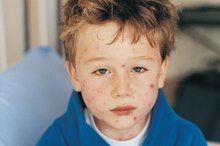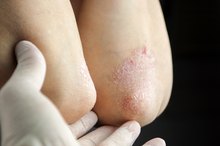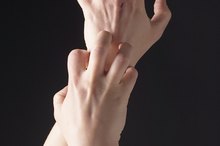Tiny Red Bumps All Over Your Face
Red bumps on your face can have a variety of causes. A rash can be caused by an allergic reaction to something in your environment, from grass to pet dander. Scabies is an infestation of the skin by microscopic mites.
Rosacea is a chronic disease that causes rash-like, tiny red bumps to form. It typically occurs on the face. To get to the root of your problem, take note of the appearance of your condition and all of your symptoms.
Common Causes
Eczema/dermatitis is an umbrella term for a variety of skin irritations, according to the National Institute of Arthritis and Musculoskeletal and Skin Diseases 2.
While some immune disorders and diseases can cause red bumps to occur on your face, the most likely scenario is a rash, allergic reaction or a type of acne.
Consider some of the most common causes and try over-the-counter treatments first. If symptoms persist or get worse, call your physician.
- Eczema/dermatitis is an umbrella term for a variety of skin irritations, according to the National Institute of Arthritis and Musculoskeletal and Skin Diseases 2.
- While some immune disorders and diseases can cause red bumps to occur on your face, the most likely scenario is a rash, allergic reaction or a type of acne.
Symptoms
A Pimple-Like Rash All Over the Body
Learn More
Seasonal allergies such as pollen, weeds and grass will cause an itchy rash with bumps. When you scratch, your face will redden more, and the bumps could increase.
Washing your face with a mild cleanser could improve these symptoms if you’re allergic to animal dander. Dander or proteins in your pet’s hair, skin, urine and saliva can also cause skin irritation in people who otherwise have no allergic reaction to animals.
A rash could be caused by dry skin or an irritant such as detergent, cleaning solution or even fragrance in a soap or body lotion.
A rash could either itch or just feel irritated.
Washing your skin will not improve your symptoms. If the red bumps are caused by an acne breakout, it probably won’t feel itchy or irritated.
Rosacea is a common skin disease.
The American Academy of Dermatology (AAD) says rosacea can resemble blushing, but leaves a persistent redness in the center of the face, which can gradually spread to the cheeks, forehead and chin. Rosacea is most likely to affect fair-skinned adults between the ages of 30 and 50.
- Seasonal allergies such as pollen, weeds and grass will cause an itchy rash with bumps.
- Washing your face with a mild cleanser could improve these symptoms if you’re allergic to animal dander.
At-Home Treatments
If your face is itchy, and the redness increases when you scratch, try taking an over-the-counter antihistamine such as Allegra or Claritin. Seasonal allergies to grass, weeds and pollen can cause a rash. Dander from your pet, which will affect your face after petting an animal and touching your skin, can cause a temporary flare-up that may subside once you wash your face and hands with soap and stop scratching.
If you believe this could be acne, try washing your face with a mild cleanser and applying topical benzoyl peroxide. While it could take several days or weeks before the breakout begins to clear, you may start noticing other signs of improvement, such as fewer bumps and a less oily complexion.
Rosacea is a persistent condition and will likely just worsen. Once you’re sure it’s not an allergy or a reaction to a chemical, the AAD recommends seeking treatment.
- If your face is itchy, and the redness increases when you scratch, try taking an over-the-counter antihistamine such as Allegra or Claritin.
- Dander from your pet, which will affect your face after petting an animal and touching your skin, can cause a temporary flare-up that may subside once you wash your face and hands with soap and stop scratching.
When to Seek Treatment
Causes of Tiny, Red Bumps on Fingers
Learn More
Even doctors suggest treating the most obvious causes yourself first, such as dermatitis or allergies. But once you’ve decided that the problem is more serious, such as if symptoms worsen or persist, if the rash spreads to other areas of your body or other symptoms begin to occur, leave the diagnosing to your doctor.
Be sure to tell him what steps you’ve taken at home to control the symptoms so that he can rule out the causes you’ve treated. Dozens of diseases can cause red bumps, including rare anemic disorders; contagious viruses such as hand, foot and mouth disease; and immune disorders.
- Even doctors suggest treating the most obvious causes yourself first, such as dermatitis or allergies.
- But once you’ve decided that the problem is more serious, such as if symptoms worsen or persist, if the rash spreads to other areas of your body or other symptoms begin to occur, leave the diagnosing to your doctor.
Why You Shouldn’t Panic
The likelihood of your condition being something serious, contagious or life threatening is minuscule.
Even if antihistamines, cleansing and topical ointments don't clear the problem instantaneously, you may still just have a stubborn case of eczema or dermatitis. And getting worked up into a frenzy won’t help. The National Institutes of Health (NIH) reports that seborrheic dermatitis, a common inflammatory skin condition, can be caused by and worsen when a person is stressed out or anxious 3.
- The likelihood of your condition being something serious, contagious or life threatening is minuscule.
- Even if antihistamines, cleansing and topical ointments don't clear the problem instantaneously, you may still just have a stubborn case of eczema or dermatitis.
Related Articles
References
Resources
Writer Bio
Shannon Marks started her journalism career in 1994. She was a reporter at the "Beachcomber" in Rehoboth Beach, Del., and contributed to "Philadelphia Weekly." Marks also served as a research editor, reporter and contributing writer at lifestyle, travel and entertainment magazines in New York City. She holds a Bachelor of Arts in literature from Temple University.









